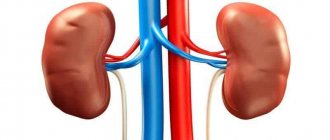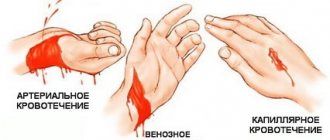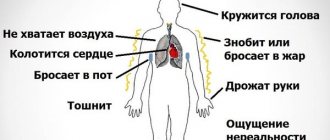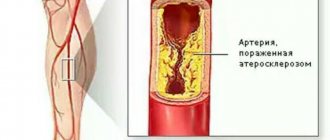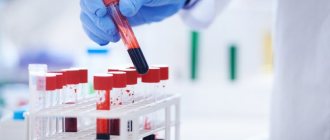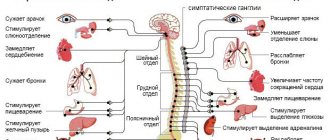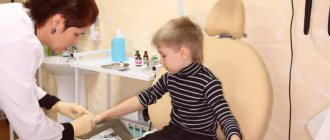Causes of cardialgia
Cardialgia, as a functional condition, does not harm the patient’s health and is not life-threatening. In this case, it is necessary to treat cardiac pain. It is a manifestation of diseases developing in the human body. Therefore, to eliminate pain, existing diseases are treated. Factors that cause cardialgia are divided into cardiac and extracardiac.
From the side of the heart
Most often, cardialgic pain is confused with the patient’s condition during an angina attack.
It is important to be able to distinguish between these diseases, since they have similar symptoms. If an angina attack is left untreated, it turns into a heart attack.
Then, in the area of the projection of the heart, after physical or emotional stress, squeezing and pressing pain appears. Taking nitroglycerin for angina does not provide relief.
In addition to angina, pain in the heart area is caused by some other pathologies:
- Cardiomyopathy is a structural change in the muscle tissue of the heart that interferes with the normal functioning of the ventricles. The disease has different forms and develops due to inflammatory processes, dystrophy or a sclerotic condition in the heart muscle.
- Dissecting aortic aneurysm is recognized as a fatal condition for the patient, in which blood accumulates between the membranes of the aorta.
- Hypertension that occurs against the background of hypertrophic changes in the left ventricle.
- Myocarditis, which is an inflammation of the heart muscle of an acute or chronic nature.
- Various disorders associated with deformation of the heart valves or great great vessels.
- Hypertrophy of the left ventricle, resulting from prolonged hypertension or stenosis at the aortic mouth.
- Pericarditis, accompanied by the release of fluid into the space between the pericardial layers or fusion of the membranes.
- Bacterial endocarditis, which occurs due to infection with streptococci or intravenous administration of certain drugs.
Important!
Any of these processes cause pain in the lining of the heart. It is different from angina pain. During an attack of cardialgia, discomfort is caused by breakdown products of cellular metabolism, irritating nerve endings. During a heart attack or angina, pain develops due to the impact on the cells of the heart muscle or coronary arteries. Therefore, various medications are used to relieve pain.
From other authorities
Sometimes cardialgia is caused by diseases of organs located near the heart. Then they talk about thorocoalgia, since the painful syndrome does not depend on heart pathology, but only imitates it. In addition, pain in the heart can be of a reflex nature and develops simultaneously with discomfort in a nearby organ.
Cardialgia is provoked by the following diseases:
- Pathological processes associated with the musculoskeletal system. These include intervertebral hernia localized in the cervicothoracic region of the spinal column, curvature of the spine, injuries in the chest area, osteochondrosis, intercostal neuralgia. All these diseases occur both in adulthood and in young people.
- Pathologies of the digestive system, which include esophagitis of various forms, reflux disease, gastritis, ulcers, cancer, pancreatitis, cholecystitis and others.
- Diseases of the respiratory system, which include bronchitis, pneumonia, laryngotracheitis, lung cancer.
- Pathological conditions of the mediastinal organs, including mediastinitis, pneumomediastinum, cancer of the lymph nodes.
How do breathing problems mimic heart pain?
When analyzing the nature of pain, it is necessary to take into account the individual dependence of each person on the threshold of pain perception, sensitivity, and the state of the nervous system. Patients' complaints can look very colorful, be described emotionally, but have no objective signs of pain.
And other “silent people” have the patience to stand in line for an appointment and literally put their immobilized hand on the table. We will analyze the most typical manifestations of cardialgia syndrome in relation to its causes.
In addition to coronary disease, there is another pathology that is accompanied by pain in the heart area.
Myocarditis is an intermittent pain syndrome, mildly expressed, the disease is detected by rhythm disturbances and signs of cardiac decompensation:
- tachycardia,
- shortness of breath at rest,
- swelling on the feet.
In diagnosis, it is important to find out the connection with a recent infectious disease (influenza, ARVI, scarlet fever, tonsillitis).
Exudative pericarditis - pain resembles angina pectoris, but lasts much longer and is not relieved by Nitroglycerin. They can be “dumb” in nature. They are accompanied by compression of the esophagus, so the patient has difficulty swallowing. The patient's face is sharply cyanotic, and shortness of breath is significantly pronounced.
More article: Pressing pain in the heart
Aortic aneurysm - the pain is constant if nearby nerves are involved in the inflammatory process, and unstable if at the initial stage only compression occurs during a change in body position. They radiate to the shoulder, left arm and shoulder blade, interscapular area. Accompanied by hoarseness, dry cough, hiccups. Compression of adjacent nerves and veins causes:
- swelling of the face, neck;
- constriction of the pupil and retraction of the eyeball;
- dilation or constriction of blood vessels in the left half of the head and neck;
- cyanotic skin tone.
When an aneurysm dissects, the pain comes suddenly, is cutting in nature, and is often associated with physical effort. Possible picture of shock:
- cold sweat,
- pressure drop,
- loss of consciousness,
- convulsions.
Diseases of the lungs and pleura of inflammatory nature most often imitate cardialgia with:
- pleurisy with effusion into the pleural cavity;
- left-sided lobar pleuropneumonia;
- left-sided pneumothorax (penetration of air into the pleural cavity with compression of the lung).
If the onset is caused by pneumonia, then, in addition to pain, the patient will have a high fever, cough with sputum, and signs of intoxication. The maximum pain occurs when trying to take a deep breath. Because of this, the patient's breathing is shallow.
Left-sided pleurisy can be detected using radiography
Pneumothorax occurs during trauma, in patients with cavernous tuberculosis. The condition is equivalent to shock, the pain is very intense. Due to compression of the lung, the patient has severe respiratory failure with suffocation.
Causes of cardialgia
Until a final diagnosis is made, all pain symptoms in the left side of the chest are considered functional cardialgia. This pathology may be associated with heart disease, or be a consequence of dysfunction of another organ.
Heart reasons
- Angina pectoris.
- Stroke.
- Myocardial infarction.
- Dyshormonal cardiomyopathy. Occurs during puberty, with pathological disorders in the thyroid gland, and with hormonal therapy.
- Myocardial hypertrophy is the growth of the heart muscle under the influence of high blood pressure, professional sports, and heavy physical work.
- Myocarditis is an inflammatory phenomenon in the muscular structure of the heart. This is due to bacterial and viral infections.
- Pericardial or endocardial dysfunction.
- Mitral valve prolapse is a defect in the valve leaflets, causing some of the blood to flow back into the atrium.
- Cardialgia associated with abnormalities in the heart and blood vessels requires prompt and urgent treatment.
Extracardiac causes
Neurocirculatory dystonia (NCD). It is formed if the work of various parts of the central nervous system is unbalanced. Chest pain is accompanied by respiratory distress, sweating, and dizziness. A person with NCD is anxious, suspicious, mentally unstable, and gets tired quickly.
The pain begins after severe nervous shock or physical overload. Taking nitroglycerin has no effect, since the attack is not associated with vasoconstriction. The disease affects young people under 35 years of age.
Depression and neuroses. Dysfunction of the cerebral cortex causes pain in the heart, rhythm disturbances, and fear of death.
Such patients often develop psychogenic cardialgia (cardioneurosis), the development of which is facilitated by nervous breakdowns, difficulties in adaptation, and intractable problems.
Fear for health forces a person to go to doctors and agree to numerous examinations. The fact that no pathologies can be found does not reassure the patient, but suggests an incurable disease. Cardiophobia develops - fear of a heart attack, cardiac arrest or rupture.
Cervicobrachial syndrome. In addition to pain in the left side of the chest, it is characterized by a decrease in blood pressure in the left arm, low body temperature, and swelling of the arms. The reason is compression of the subclavian vessels and nerve endings. Pain occurs when carrying heavy objects or raising your arms above your head.
Osteochondrosis (damage to the intervertebral cartilage) or hernia (protrusion) of the intervertebral disc. Chest pain often appears at night, with a reflex position of the body (when the arms are pulled up or placed behind the head). The nerve fibers in this position are compressed, and a prolonged immobile position further aggravates the situation.
This also includes the so-called vertebrogenic cardialgia - a consequence of degenerative disorders in the thoracic spine. Severe pain in the heart occurs when turning the head or torso, when sighing, coughing, or waving a hand. With such disorders, you should urgently go to an orthopedist.
Herpes zoster, thoracalgia (intercostal neuralgia), neuroma of the spinal nerves. With these diseases, chest pain can be intense and last for several days. Even powerful drugs like morphine cannot relieve it. This fact makes the diagnosis easier.
Inflammation of the mediastinum (anatomical space between the lungs) with compression of nerve endings.
Exhaustion, protein deficiency, alcoholism. Here, the symptoms of cardialgia are associated with metabolic disorders.
Stomach ulcer, diaphragmatic hernia, esophagitis. Painful symptoms disappear after standing up or taking antacids.
Tracheitis, bronchitis, pulmonary hypertension, pleurisy, lung cancer.
Pregnancy, childbirth, menopause in women.
High position of the diaphragm in obesity.
Rapid growth in children, disorders of nervous regulation in adolescents.
In all of these conditions, there are no visible organic disorders of the heart and coronary vessels. The course of cardialgia in these cases is benign, the life prognosis is good.
Causes of the disease
The development of this syndrome is associated with excessive excitation of the vagus nerve. This occurs due to increased sensitivity and stretching of the endings of the nerve fibers occupying the lower cavity of the esophagus, one of the intestinal sections and the cardiac zone of the stomach.
Typically, gastrocardial syndrome is formed under the influence of the following health problems:
- ulcer;
- malignant tumors;
- arterial pathology;
- diaphragmatic hernia.
People with the following problems are at risk:
- mild excitability of the central nervous system;
- hypersthenic physique;
- obesity.
Older men and women, as well as people who frequently overeat, are prone to developing the syndrome.
Symptoms of cardialgia
Painful sensations in the heart area depend on the position of the body, for example, they intensify from bending forward, if you raise your left arm up, from taking a deep breath, when carrying heavy objects, when driving a car.
The nature of the pain may be stabbing, cutting, aching. Patients with cardialgia experience mortal fear, feel a lack of air, begin to panic, the heartbeat increases, sweating appears, the vision becomes dark, and a headache begins.
Patients note a decrease in body temperature, swelling of the hands, and low blood pressure. Swallowing may be difficult (Barré-Lieu syndrome), which is more common in older people with short necks. When the subclavian artery is compressed (Naffziger syndrome) and in the presence of an additional cervical rib (Falconer-Weddell syndrome), patients complain of shoulder pain radiating to the palm, low blood pressure, chilliness, and weak pulse.
If this is psychogenic cardialgia, then pain is more often observed in the apex of the heart, and the pain can move. Cardialgia of a vegetative crisis is characterized by very long-term pain of a pressing or aching nature; Validol and Nitroglycerin in this case do not alleviate the condition. At the same time, blood pressure increases, so cardialgia of a vegetative crisis can be confused with a hypertensive crisis. Patients note lethargy, weakness, a feeling of fear, tremors appear in the body, shortness of breath may begin, a feeling of lack of air appears, and the heartbeat quickens.
Sympathalgic cardialgia is characterized by severe burning pain in the heart and behind the sternum. In this case, patients complain of severe skin soreness. With cardialgia associated with diseases of the gastrointestinal tract, in addition to pain in the heart, the patient is worried about nausea or vomiting, a feeling of heaviness on the left side under the ribs, a swollen stomach, heartburn, a sour taste in the mouth, and belching.
With cardialgia associated with pneumonia and pleurisy, high body temperature, weakness, poor health, pallor, shortness of breath, cough (initially dry, then wet) are noted, and chest stiffness appears on one side.
If the causes of cardialgia are diseases of the spine, then the patient is bothered by back pain and interscapular pain. With osteochondrosis, the pain in the heart takes on a cutting, stabbing, shooting character, the pain radiates to the arm, numbness appears, the sensitivity of the limbs decreases, and tingling appears. With intercostal neuralgia, the pain is short-term, stabbing.
With dishormonal cardialgia, there is a feeling of heaviness, tightness in the chest, cutting, burning, piercing pain, which can be long-term or short-lived, often at night. Often, patients do not have enough air; this is not true shortness of breath, but a feeling of lack of air. There may be loss of consciousness, fainting, pain is accompanied by characteristic “hot flashes”, increased sweating, tingling sensation, headaches, palpitations, a feeling of cardiac arrest, spasms in the throat, dizziness. The mood of patients is reduced, irritability and emotional lability are characteristic.
How does an attack of cardialgia occur?
An attack of cardiac syndrome begins with a feeling of compression of the chest, usually the left part. Then the pain becomes burning, aching and cutting. Nitroglycerin does not help in this case.
During an attack, a person begins to sweat, becomes irritable, complains of headaches, a feeling of cardiac arrest, and a feeling of fear of death. Attacks can be short (a few seconds) or long (up to several hours).
The attack affects the person so much that after it ends the patient becomes helpless, so psychological help is needed. The support of loved ones in such situations plays a big role. After an attack, people return to their normal lives without loss of ability to work.
Symptoms of cardialgia
As you may have guessed, any pain in the left side of the chest, until a final diagnosis is made, is regarded as cardialgia. Let's look at the most common symptoms of cardialgia and the causes of its occurrence.
Quite often in medical practice, cardialgia in a patient is a sign of the development of neurocirculatory dystonia. This disease is characterized by fatigue, prolonged pain in the heart, and a feeling of insufficient inspiration. It is also possible to have headaches and a constant feeling of anxiety for any minor reason. Taking nitroglycerin in such cases is useless; it will not relieve the patient of pain, since cardialgia is not associated with vasoconstriction, and the medicine will be ineffective here.
Cardialgia can be caused by a herniated disc and osteochondrosis, while the intensity of the discomfort does not depend on physical activity. They intensify with a certain position and movement of the head or hands. The most unpleasant sensations occur during sleep, when the sleeper reflexively moves his arms to the side or under his head. Such cardialgia, the symptoms of which are described above, is in no way associated with heart disease. The cause of its occurrence should be eliminated by an experienced orthopedic doctor, from whom it is necessary to seek help as quickly as possible.
Cervicobrachial syndrome leads to compression of the subclavian arteries and veins. As a result, a person, when carrying heavy objects and raising his arms up, feels pain in the left side of the body. Patients also experience low blood pressure, low body temperature, and swelling of the hands. You should not be afraid of this, as this is a description of the symptoms of cardialgia, which indicate pathological hypertrophy.
Cardialgia often appears as a result of intercostal neuralgia, herpes zoster or root neuroma. The latter disease can cause such severe cardialgia in the patient that even morphine cannot help. This fact is one of the main ones when making a final diagnosis.
If you are overweight, then do not be surprised if you find symptoms of cardialgia. People who lead a sedentary lifestyle are also susceptible to this disease. Unpleasant sensations occur immediately after eating and are often confused with angina pectoris. The correct diagnosis - whether you have cardialgia or not - can be made only after a thorough history preparation.
Aching and stabbing pain in the left region of the chest also appears in diseases such as pleurisy, pulmonary hypertension, myocarditis and pericarditis. They are often confused with symptoms of cardialgia. To identify an accurate diagnosis, examination and consultation with a competent doctor is necessary.
Why does this syndrome occur?
The etiology of the syndrome is currently unclear. But there are factors that provoke the development of pathology.
They are as follows:
- increased sympathetic activity;
- changes in microcirculation;
- disorders of endothelial functions;
- hyperkalemia;
- a large amount of insulin in the blood;
- excessive sensitivity to pain;
- thoracic osteochondrosis;
- chronic inflammatory process;
- increased arterial stiffness.
As a rule, syndrome X occurs in women during menopause. They feel chest pain similar to an angina attack, but it is not relieved by nitroglycerin. At the same time, a mental illness can be identified. There are other situations - if women during menopause start taking hormonal drugs, then pain in the chest area decreases.
Diagnosis and differential diagnosis
Based on the nature of pain in the heart area, the doctor can suggest one or another diagnosis in a patient with cardialgia. To do this, you should know some of the features of pain syndrome in various pathologies.
So, if a patient describes pain in the chest as pressing or burning, occurring after exercise and going away on its own or after taking nitroglycerin, then the doctor should suspect a serious pathology such as angina pectoris. A long-term intractable attack of angina (for 15 minutes or longer) may indicate the development of myocardial infarction, which, in turn, is characterized by pronounced intense pressing or burning pain in the chest. Thus, the pressing or burning nature of pain in the heart area indicates angina pectoris or myocardial infarction.
Also, the doctor should be alert to very pronounced, severe pain in the heart area, radiating to the shoulder blades or lower back, caused by a dissecting aneurysm of the thoracic aorta. The patient is tossing about in pain, cannot take one position, and the patient is in a general serious condition, close to shock.
Stitching, shooting, pulsating, diffuse nature of pain is more typical for cardialgia caused by heart disease, as well as for functional cardialgia with VSD or with increased psycho-emotional stress. In addition, “shooting” pain, which intensifies when trying to take a deep breath and when changing body position, is a pathognomonic symptom of intercostal neuralgia and osteochondrosis.
Burning or bursting pain that intensifies after eating, the occurrence of pain in the morning after a long stay in a horizontal position, the inability to freely swallow food (dysphagia), the need to wash down food with cold or warm water, are most characteristic of gastroesophageal reflux or achalasia cardia. Pain in the heart area, accompanied by pain in the hypochondrium, nausea and vomiting, may indicate the development of acute or exacerbation of chronic cholecystopancreatitis.
If there is pain in the chest, accompanied by high body temperature, soreness behind the sternum and cough, the doctor should rule out an inflammatory process in the trachea and bronchi. If the patient has developed pleuropneumonia or pleurisy, pain in the left or right half of the chest becomes more pronounced and resembles the pain syndrome of intercostal neuralgia.
In order to conduct a full differential diagnosis of cardialgia, the doctor must refer the patient to undergo instrumental research methods. So, any patient with cardialgia must undergo an ECG and chest x-ray. Further, depending on the nature of the pain in the chest, the patient undergoes FEGDS, ultrasound of the heart and internal organs, X-rays, MRI of the thoracic and cervical spine, and in diagnostically unclear cases - CT or MRI of the entire chest cavity. The final diagnosis for a patient with cardialgia is established after a complete clinical and laboratory-instrumental examination.
Therapy of the syndrome
Unfortunately, no specific treatment for syndrome X has been developed in our time. The basis for the choice of therapy is the identified cause of the attack. Often, consultation with other specialists is necessary, as well as an integrated approach to treatment.
Depending on the presence of certain symptoms, doctors may prescribe the following groups of medications:
- Antianginal agents.
- Antihypertensive drugs.
- Sedatives.
- Non-steroidal drugs.
- Psychotropic medications.
An important factor in the treatment of cardiac syndrome is lifestyle. There are situations when a doctor advises a patient to change his place of residence or change his job.
In addition, it is recommended to monitor your weight and blood cholesterol levels. If it is elevated, the doctor will prescribe drugs from the statin group.
Note! The specific drug and its dosage should be selected only by the attending physician. If pain in the heart area is psychological in nature, then a consultation with a psychotherapist will play a major role in such treatment.
Functional cardialgia
Possible causes of cardialgia were listed above. If, during a detailed examination, no organic pathology of the heart or other organ was identified in the patient, then the likelihood of functional cardialgia is considered for him. This diagnosis is especially appropriate for a young patient who has a history of vegetative-vascular dystonia, and also does not comply with the principles of a healthy lifestyle, which include adequate sleep, proper nutrition, and the absence of stressful situations. That is, almost any modern resident of a metropolis with a constant lack of sleep and irregular fast food snacks, experiencing colossal psycho-emotional overload at work, has every chance of getting not only gastritis, but also functional cardialgia.
A separate psychogenic form of cardialgia is distinguished, which is caused by the patient’s strong experiences and is more common in young women with a labile and mobile psyche. In this form, the patient has no signs of organic damage to the internal organs, and pain in the heart is accompanied by severe fear of death, lack of air and inability to breathe, as well as other signs of a panic attack.
In menopausal women, functional cardialgia may also occur due to hormonal imbalance in the body. But you should still be on guard, because after ovarian function fades completely and female sex hormones become insufficient to fulfill their protective properties, a woman’s risk of developing heart attacks and strokes increases.
Treatment of cardialgia
Treatment of cardialgia requires breaking the chain of nerve connections that mimic heart pain. The most acceptable are sedatives with a mild calming effect (tinctures of motherwort, valerian, Corvalol, Novopassit). These are herbal preparations that are not addictive.
Severe pain requires painkillers.
For vertebrogenic symptoms, Nise, Ketorol with Nimesulide help, B vitamins and physiotherapy (electrophoresis, ultrasound, diadynamic currents) are prescribed. Compression of the vertebral discs requires treatment with traction and consultation with a surgeon.
Persistent ulcerative pain and esophagitis may be an indication for surgical treatment in order to prevent progression to a cancerous tumor. To reduce pancreatic secretion, antispasmodics (Atropine sulfate, Platiphylline) and antienzyme agents (Kontrikal or Gordox) are used.
Non-coronary heart diseases have their own treatment principles: antibiotics, cardiac glycosides, diuretics, β-blockers.
In all cases of cardialgia, a person’s concerns should be approached with attention and sympathy. Only a complete examination and consultation with an experienced doctor will rule out heart disease.
In order for the patient to get rid of the symptoms of cardialgia, it is necessary to cure the diseases that cause it. Treatment is carried out by a specialized specialist in a narrow field.
For example:
- Cardiologist;
- Neurologist;
- Endocrinologist;
- Pulmonologist;
- Gastroenterologist;
- Psychotherapist.
Treatment may be accompanied by:
- Changing your lifestyle. For example, it is necessary to have regular physical activity (running, swimming, walking), adequate sleep, and also to exclude all kinds of stressful situations;
- Long-term drug therapy. It includes limited physical activity; the use of drugs that relieve inflammation; diuretics (remove excess fluid in the body);
- Psychotherapy and following all the advice of a psychotherapist will greatly reduce the strength and frequency of unpleasant sensations. Also, an appointment with a specialized doctor will help you get rid of fear and panic at the time of the attack, and will also put you in a favorable mood.
At the same time, if you find symptoms of cardialgia, you need to take any remedy to calm you down. For example, valocordin, corvaldin or corvalol. If the pain does not stop, you need to take analgin or pentalgin, and put a validol tablet under your tongue.
You also need to go out into the fresh air or open a window. If there is no positive effect within half an hour, you must call an ambulance.
Psychogenic cardialgia: symptoms and treatment
This type of cardialgia develops as a result of depression or stress. With psychogenic cardialgia, the symptoms are pulsating and constant.
Patients note pain and burning in the cardiac zone, as well as in the left hypochondrium. In this case, there may be either a feeling of fullness or emptiness in the chest.
In addition, patients often indicate increased sensitivity of the skin of the left nipple.
Psychogenic cardialgia, the symptoms of which are somewhat different from those of pathologies of other origins, may be accompanied by irradiation of pain to the spine, lower back, neck and genitals. In addition, the pain is often combined with tingling, tingling, crawling and other unpleasant sensations.
Treatment of this form of the disease comes down to eliminating the main etiological factor (that is, stress and depression), carried out by prescribing antipsychotics, antidepressants, and so on.
What does cardialgia look like in digestive diseases?
Cardialgia caused by diseases of the digestive system occurs with painful manifestations and is most often associated with food intake and overeating. Accompanied by:
- nausea,
- heartburn,
- belching,
- vomiting,
- bloating,
- stool disorder.
Inflammation of the esophagus in the lower part causes a severe burning sensation behind the sternum, spreading to both sides and upward. The pain intensifies when swallowing, especially solid foods. They radiate to the back, to the spine.
A stomach ulcer is accompanied by heart-like pain. They are triggered by eating. They appear suddenly, but last a long time. Sometimes patients induce vomiting on their own to improve the condition. The epicenter of pain is under the left costal arch or just under the sternum. Spread to the shoulder, back, lower abdomen.
Acute pancreatitis is severe with paroxysmal stabbing pains. They are localized in the upper abdomen, radiating to the left clavicle, both shoulder blades, and the posterior lower parts of the ribs. In duration they differ from cardiac ones by a significant duration (up to three days). Then the intensity decreases, and dull and aching pain remains. An important symptom is repeated painful vomiting that does not bring relief.
Classification
Non-coronary heart pain is divided into 2 forms depending on the pathogenesis. Both types occur without functional disturbances in the myocardium.
Psychogenic form
If, after a complete examination of the patient, no changes in the structure of the heart were detected, then they speak of functional cardialgia, in the formation of which the psychogenic factor plays a major role. Most often, this form of cardialgia is observed in young people with vegetative-vascular dystonia.
- violation of sleep, work and rest patterns;
- irrational, unbalanced diet;
- long-term stress and depression;
- excessive physical activity.
The psychogenic type affects mainly young girls with a neurotic character.
Vertebrogenic form
Vertebrogenic cardialgia is observed in diseases of the upper spine. Pain can radiate to the heart area when the nerve roots of the cervical spine are pinched.
Often the vertebrogenic form develops against the background of osteochondrosis with a sedentary lifestyle. The position of the intervertebral discs changes, nerve endings are pinched and blood circulation is disrupted. The pain intensifies when raising the arms, turning the head and changing body position.
A similar clinical picture is observed in cervicobrachial syndrome, which is characterized by damage to the nerve endings of the brachial plexus and cervical spine. The pathology is typical for older people. In addition to the pain syndrome, numbness of the left arm and swelling are also noted.
Cardialgia can also be caused by Falconer-Weddell syndrome - this is a costoclavicular pathology, which is expressed in a narrowing of the space between the first rib and the collarbone. The neurovascular bundle in the left arm is compressed, which provokes pain in the left half of the chest.
Cardiac syndrome develops not only due to heart disease, but also for other reasons not related to the functioning of the cardiovascular system. Chest pain can be caused by pathological changes in the internal organs, spine, and respiratory system.
Related to the heart
Severe pain syndrome may be associated with the following heart diseases:
- Angina pectoris. The disease is associated with a violation of the supply of oxygen and nutrients to the myocardium.
- Myocarditis is an inflammatory process in the heart muscle.
- Myocardial infarction. Progressive ischemia provokes necrosis of the heart muscle.
- Cardiomyopathy is an increase in the size of the heart cavities and a decrease in its pumping function.
- Heart valve defects.
- Pericarditis.
- Hypertrophy of the right or left ventricle.
Other factors
Cardiac syndrome can be caused not only by heart disease. In this case, the pain radiates from another source and imitates cardialgia. Pathologies that provoke extracardiac cardialgia:
Pain syndrome can be caused by traumatic injury to the spine, pulmonary system, or abdomen.
Women during menopause, as well as during pregnancy, may experience chest pain of an idiopathic nature. In children and adolescents, pain may be associated with hormonal changes and a period of active growth. Such conditions do not require specific treatment and go away on their own.
Diagnostics
An accurate diagnosis for patients with cardialgia syndrome is made based on the nature of the pain. To do this, take into account the characteristics of pain in various diseases.
If a person’s pain is of a pressing or burning nature, develops after exercise and subsides spontaneously or after taking nitroglycerin, then the doctor suspects angina pectoris. If the attack does not subside for more than a quarter of an hour and is accompanied by a severe painful syndrome of a burning or pressing nature, they speak of a heart attack.
Very severe and pronounced pain should also alert the attending physician. Especially if it radiates to the lumbar region or shoulder blades. This condition is typical for a dissecting thoracic aortic aneurysm. It is difficult for the patient to maintain a constant body position. He is in a state of shock.
Shooting, stabbing, diffuse or throbbing pain is typical for cardialgia from the heart. This condition also occurs with a functional disorder with VSD or severe emotional shock. For intercostal neuralgia and osteochondrosis, additional characteristic symptoms are “lumbago” when trying to change body position or take a deep breath.
Pain of a burning or bursting nature, the intensity of which increases after eating, develops with gastroesophageal reflux. With this disease, discomfort develops in the morning, after sleep. A person cannot swallow food freely; he is forced to wash down his food with warm water.
If, along with pain in the heart, a person’s body temperature rises, there is a cough and soreness behind the sternum, then inflammation of the bronchi or trachea is suspected. With pleuropneumonia or pleurisy, the pain is concentrated on the left or right in the chest and resembles signs of intercostal neuralgia.
Important! To fully diagnose cardialgia, instrumental studies are performed. An ECG and X-ray are required. Then, depending on the accompanying symptoms, an ultrasound of the heart and other organs, FEGDS, and MRI are performed. Having made a full laboratory, instrumental and clinical examination, the correct diagnosis is established.
What not to do with cardialgia
Feeling pain in the heart, many patients panic or, conversely, do not pay any attention to the pain. Both are unacceptable and, as a rule, do not lead to anything good.
For cardialgia it is not recommended:
- make a diagnosis and prescribe treatment yourself (this can only be done by a specialist and only after a thorough examination);
- independently change the frequency and duration of therapy and replace medications prescribed by the doctor;
- for every minor ailment, call an ambulance (however, this does not apply to pain that is too intense and prolonged, which cannot be relieved by conventional means);
- overload the body with excessive physical exercise (physical education should take place, but the intensity of training depends on the characteristics of the pathology present);
- lead an unhealthy lifestyle (alcohol and smoking);
- stop working.
How is cardialgia combined with diseases of the peripheral nervous system?
Diseases of the peripheral nervous system are caused by pathology of the spinal cord and the nerves (roots) extending from it. It is necessary to distinguish:
- vertebrogenic cardialgia caused by changes in the spine due to osteochondrosis;
- radiculitis - inflammation of the outgoing roots;
- plexitis - inflammation of the nerve plexus in the front of the shoulder joint;
- myositis - damage to nerve endings in muscles.
Osteochondrosis of the cervicothoracic spine with the growth of bone spines on the processes, compression of the intervertebral disc is most often the cause of radiculitis pain.
The pain is characterized as:
- burning, similar to electric shock;
- spread along the left arm into the hand;
- provoked by changes in body position (bending, turning);
- worse when coughing, sneezing;
- may be accompanied by headaches and dizziness due to compression of the vertebral artery and cerebral ischemia;
- in the area of the changed vertebrae there is a decrease in skin sensitivity.
Plexitis is accompanied by the spread of pain along the anterior surface of the chest in the upper part from the subclavian region down and along the left arm. The limb is limited in movement due to severe pain; it is especially difficult to lift the shoulder up and move the outstretched arm back.
Intercostal neuralgia or thoracic radiculitis is manifested by girdling pain of the “shooting” type or constant along the rib. They intensify when:
- coughing and sneezing;
- hypothermia;
- deep breath;
- sudden body movements.
Read also: Situational task of pulmonary edema
Myositis is characterized by a connection with a bruise, overexertion during physical activity. The pain is constant; upon palpation, the maximum painful spot is determined, which corresponds to a subcutaneous hematoma formed as a result of a bruise.
How is cardialgia formed?
The mechanism of pain is always associated with irritation of nerve endings (receptors), of which there are millions in the heart area. They are located in all organs, in muscle tissue, in blood vessels and the heart itself. For pain to occur, impulses must be sent to the spinal cord, and then to the occipital cortex.
Nerve cells (neurons) “decide” how to evaluate signals, whether to respond to them, whether to involve the endocrine system in solving the problem, and activate sympathetic fibers. The response to pain manifests itself as:
- constriction of the pupils;
- rapid heartbeat;
- redness or paleness of the skin;
- increased sweating;
- rapid breathing;
- increased blood pressure;
- hyperthermia.
The level of adrenaline in the blood necessarily increases, and thyroid hormones and insulin in the pancreas begin to be produced more intensively.
Cardialgia follows the same path. However, it is necessary to note one feature of pulse recognition. The fact is that, upon entering the spinal centers, impulses from the coronary vessels immediately spread over a large area. Signals from other organs and muscles come here.
Thus, the spinal cord can serve as a resonator for various organs
As a result, the brain can accurately recognize the cardiac origin of the pain syndrome only in the event of excessive irritation (in the case of angina pectoris, acute heart attack). Other pains should be attributed to cardialgia of extracardiac origin.
Treatment
To help a patient with pronounced symptoms, as well as intensification of existing ailments for a long time, the following actions must be taken: 1. The sick person should be removed from poorly ventilated and crowded areas. 2. The patient must be placed comfortably in a quiet place. 3. The person providing assistance must determine the presence of a pulse, as well as its rhythm and frequency. A regular pulse indicates normal functioning of the heart, which ensures that blood circulation is maintained. 4. You should try to defuse the tense situation around the patient. 5. If the patient is conscious, then it is recommended to take one of the following medications - novopassit (1-2 teaspoons), valerian (20-30 drops), Corvalol (20-30 drops), Valocordin (10-20 drops). If there are signs of improvement in the patient’s well-being and general condition, medications can be taken during the day every 3-4 hours, and a mandatory consultation with a doctor is required. If the patient’s condition does not improve or even worsens with existing general weakness, increasing pain in the heart area, you should immediately inform the doctor at the nearest clinic or call an ambulance. In the situation described above, it is recommended to avoid creating an atmosphere of anxiety, which negatively affects the patient’s condition; there is no need to massage, rub the muscles of the limbs, or apply cold compresses to the chest area. Treatment of cardioneurosis is a rather complex and time-consuming task. The course of the disease is most often long-term, deterioration occurs due to ordinary “everyday” conflicts, and it is quite difficult to isolate the patient from them. The doctor prescribes treatment depending on the form of neurosis. But first of all, he must find out in detail the causes of the disease, conduct a full medical examination of the body, and eliminate the causes that injure the nervous system. For people with a hypersthenic form of neurosis, to increase the threshold of excitability, it is advisable to take one of the following drugs in small doses - amizil, meprotan, chlordiazepoxide, trioxazine, teralen (1 tablet once a day, duration - 7-10 days). For the hyposthenic form of neurosis, restorative medications that stimulate the central nervous system are used - diazepam, trioxazine, eleutherococcus, vitamins, securinin and an oxygen cocktail. Emotional people with obsessive-compulsive disorder and increased sensitivity are recommended to use medications such as hawthorn, valerian and motherwort. A good effect is observed when taking small doses (1 tablet per day) of eunoctin and seduxen for 7 to 10 days. In the initial stages of cardioneurosis, taking the above remedies leads to the effective elimination of attacks. Most often, patients take medications once, until the next attack, which is highly undesirable. This can lead to a chronic course of the disease, especially if the patient also has hypertension, heart disease, sclerotic changes in the myocardium, and atherosclerosis of the coronary arteries.
